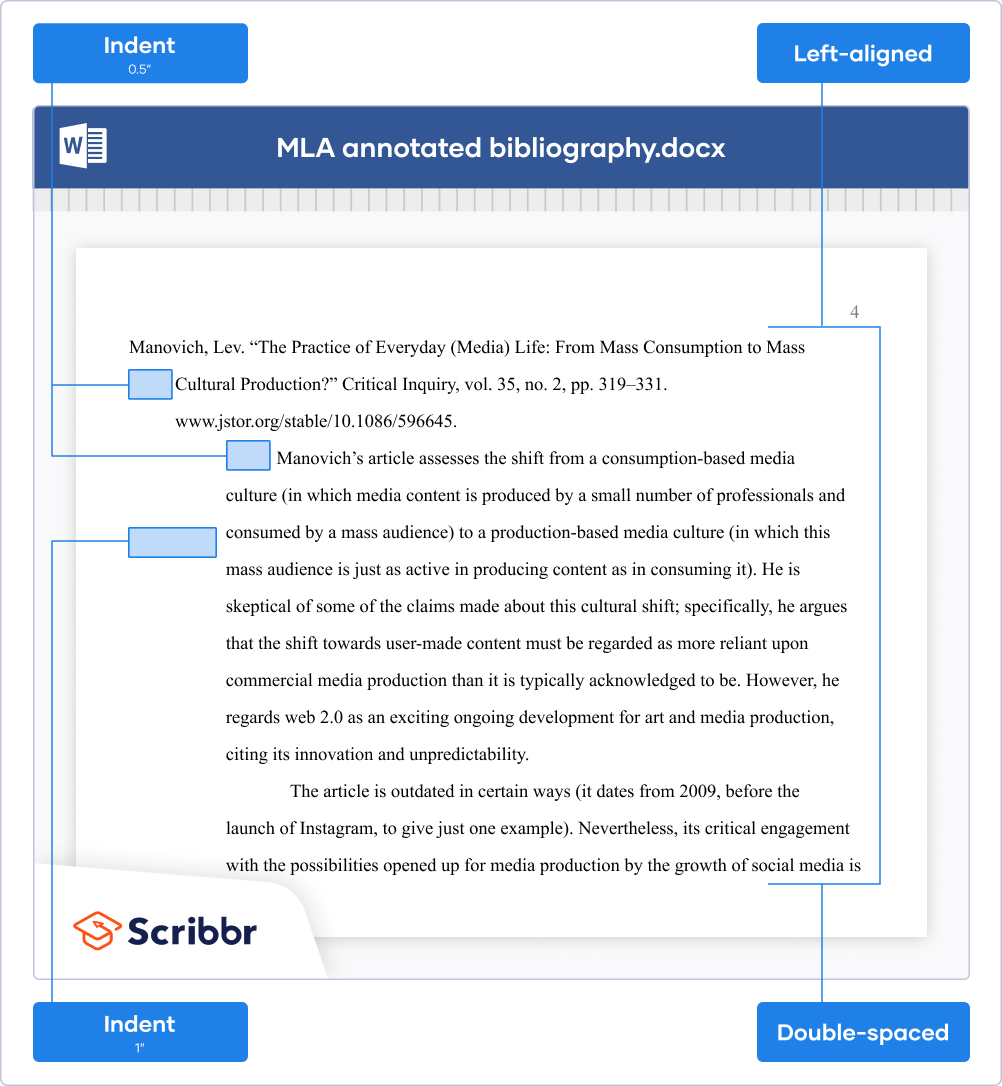MLA Style Annotated Bibliography | Format & Examples
An annotated bibliography is a special assignment that lists sources in a way similar to the MLA Works Cited list, but providing an annotation for each source giving extra information.
You might be assigned an annotated bibliography as part of the research process for a paper, or as an individual assignment.
MLA provides guidelines for writing and formatting your annotated bibliography. An example of a typical annotation is shown below.
Kenny, Anthony. A New History of Western Philosophy: In Four Parts. Oxford UP, 2010.
You can create and manage your annotated bibliography with Scribbr’s free MLA Citation Generator. Choose your source type, retrieve the details, and click “Add annotation.”
Generate accurate MLA citations with Scribbr
MLA format for annotated bibliographies
The list should be titled either “Annotated Bibliography” or “Annotated List of Works Cited.” You may be told which title to use; “bibliography” is normally used for a list that also includes sources you didn’t cite in your paper or that isn’t connected to a paper at all.
Sources are usually organized alphabetically, like in a normal Works Cited list, but can instead be organized chronologically or by subject depending on the purpose of the assignment.
The source information is presented and formatted in the same way as in a normal Works Cited entry:
- Double-spaced
- Left-aligned
- 0.5 inch hanging indent
The annotation follows on the next line, also double-spaced and left-aligned. The whole annotation is indented 1 inch from the left margin to distinguish it from the 0.5 inch hanging indent of the source entry.
- If the annotation is only one paragraph long, there’s no additional indent for the start of the paragraph.
- If there are two or more paragraphs, indent the first line of each paragraph, including the first, an additional half-inch (so those lines are indented 1.5 inches in total).
Length and content of annotations
MLA gives some guidelines for writing the annotations themselves. They cover how concise you need to be and what exactly you should write about your sources.
Phrases or full sentences?
MLA states that it’s acceptable to use concise phrases rather than grammatically complete sentences in your annotations.
While you shouldn’t write this way in your main text, it’s acceptable in annotations because the subject of the phrase is clear from the context. It’s also fine to use full sentences instead, if you prefer.
- Broad history of Western philosophy from the ancient Greeks to the present day.
- Kenny presents a broad history of Western philosophy from the ancient Greeks to the present day.
Always use full sentences if your instructor requires you to do so, though.
How many paragraphs?
MLA states that annotations usually aim to be concise and thus are only one paragraph long. However, it’s acceptable to write multiple-paragraph annotations if you need to.
If in doubt, aim to keep your annotations short, but use multiple paragraphs if longer annotations are required for your assignment.
Descriptive, evaluative, or reflective annotations?
MLA states that annotations can describe or evaluate sources, or do both. They shouldn’t go into too much depth quoting or discussing minor details from the source, but aim to write about it in broad terms.
You’ll usually write either descriptive, evaluative, or reflective annotations. If you’re not sure what kind of annotations you need, consult your assignment guidelines or ask your instructor.
Frequently asked questions about annotated bibliographies
- What is an annotated bibliography?
-
An annotated bibliography is an assignment where you collect sources on a specific topic and write an annotation for each source. An annotation is a short text that describes and sometimes evaluates the source.
- What types of sources should I use in an annotated bibliography?
-
Any credible sources on your topic can be included in an annotated bibliography. The exact sources you cover will vary depending on the assignment, but you should usually focus on collecting journal articles and scholarly books. When in doubt, utilize the CRAAP test!
- How do I write an annotation for a source?
-
Each annotation in an annotated bibliography is usually between 50 and 200 words long. Longer annotations may be divided into paragraphs.
The content of the annotation varies according to your assignment. An annotation can be descriptive, meaning it just describes the source objectively; evaluative, meaning it assesses its usefulness; or reflective, meaning it explains how the source will be used in your own research.
- Do I need to use full sentences in an MLA annotated bibliography?
-
No, in an MLA annotated bibliography, you can write short phrases instead of full sentences to keep your annotations concise. You can still choose to use full sentences instead, though.
Use full sentences in your annotations if your instructor requires you to, and always use full sentences in the main text of your paper.
Cite this Scribbr article
If you want to cite this source, you can copy and paste the citation or click the “Cite this Scribbr article” button to automatically add the citation to our free Citation Generator.
Caulfield, J. (2024, March 05). MLA Style Annotated Bibliography | Format & Examples. Scribbr. Retrieved April 22, 2024, from https://www.scribbr.com/mla/mla-annotated-bibliography/


